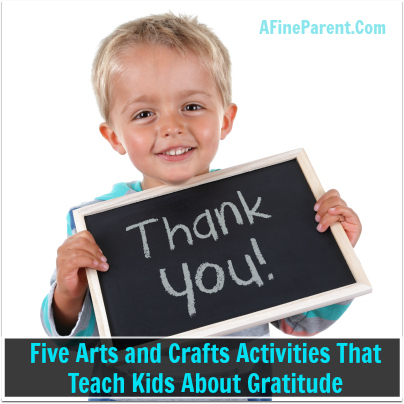 Kids take things for granted: the food they eat, the clothes they wear, their toys, trips, extracurriculars.
Kids take things for granted: the food they eat, the clothes they wear, their toys, trips, extracurriculars.
And why wouldn’t they? For most kids, food appears when they are hungry, there are clothes in the closet, and a list for Santa is an annual tradition.
How do we teach our kids to be grateful, especially for the things they take for granted?
My kids say thank you for meals at dinnertime mainly because it has been drilled into them since they first sat in a highchair: you thank the person who provides you with food. Same with thanking gift-givers and treat providers. “What do you say to Grammie for that baseball?” In fact, teaching please and thank you becomes so ingrained as a parent that you might find yourself, as I often did, catching yourself saying “What do you say…?” before the kids have time to even spit out their thanks.
When my kids were three or four I was so proud of them when they piped out a “thank you” without prompting I’d heave a little internal sigh: at least I’ve done something right as a parent!
But gratitude, as we all know, goes way beyond mouthing thanks for the things we are given.
Having, feeling, and expressing gratitude helps to foster empathy and generosity and is linked to life-long well-being and happiness.
As kids age, it is so important to instill in them a sense of gratitude for everything they are surrounded with in order to prevent them from growing up spoiled, over-privileged, and blinded to the inherent inequalities of life.
In our house at Thanksgiving dinner, it has become a tradition to go around the table and give everyone a chance to say what they are thankful for. The responses range from “health and family” from the older generation to “hockey and Disneyland” and “mashed potatoes and gravy” from the younger.
It has become a time to reflect on how fortunate we are for what we have. But beyond the typical or humorous response, we as parents know that gratitude is an emotional state that needs to be fostered beyond one night a year.
How do we make gratitude a daily practice?
At the Raising Grateful Children project at UNC Chapel Hill researchers have determined that “Gratitude is associated with many positive outcomes including more satisfying social relationships and decreased distress and mental illness in adults.”
According to researchers, we as parents, while mindful of teaching kids what to do to show gratitude – saying thank you, for example – often neglect other aspects that are important for fostering the full experience of gratitude: how to notice the world we live in, to think about the things we’ve been given, and to determine how we feel about what we’ve been given.
The teaching to say thank you is the easy part. The rest involves more in-depth conversation that is sometimes difficult to initiate without sounding like a boring lecture. How do we sit down with our kids and teach them about gratitude without sounding preachy and having them tune out?
A great way to broach the topic is through arts and crafts, and not just at Thanksgiving, although one of the crafts below is perfect for that as well.
Sitting down together and completing a craft geared towards gratitude provides the perfect time and space to converse about what we are grateful for, what gratitude means to us, how we can be more grateful for what we have, and reflect on how being grateful makes us feel.
The five crafts below are a mixture of one-time art projects and on-going crafts meant to foster discussion of gratitude and encourage gratitude to become a daily practice in our kids’ lives.
1) Placemats for Thanksgiving
Decorate placemats with a message or list of things we are thankful for.
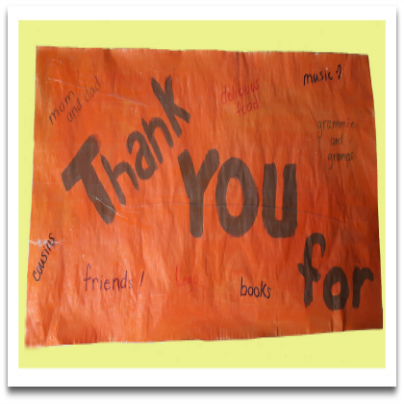 Benefits: gets kids thinking about more than pumpkin pie and stuffing
Benefits: gets kids thinking about more than pumpkin pie and stuffing
What you need: Construction paper or Bristol board (or even a piece of cardboard about 15” x 10”; crayons, colored pencils or paint; clear packing tape. Optional: magazines and flyers
What to do:
- Cut the paper into placemat size.
- Write what you are thankful for (mom and dad, a warm house, kittens.)
- Draw pictures representing what you are thankful for.
- If your child prefers cutting and pasting to drawing, he can cut pictures out of magazines and flyers that represent things he is grateful for and glue them to the placemat.
- “Laminate” the placemat if you want, using clear packing tape: use pieces of tape that are a little longer than the paper; smooth the tape over the front of the artwork and fold the excess over the back to make the placemat stiff and protect it from spills.
2) Thank You Cards
Create hand-written cards (so much better than email!) and embellish them with pictures, doodles, or collage elements.
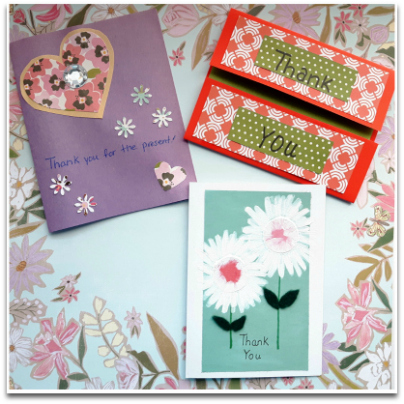 Benefits: encourages kids to show gratitude for the things they receive, beyond simply saying “thank you.” The added step of a thank-you card provides an opportunity for kids to reflect on the present they have been given or the act of kindness they are thanking for.
Benefits: encourages kids to show gratitude for the things they receive, beyond simply saying “thank you.” The added step of a thank-you card provides an opportunity for kids to reflect on the present they have been given or the act of kindness they are thanking for.
What you need: Construction paper, card stock, or simply some plain paper. Pencils, crayons, or markers. Envelopes and stamps.
What to do:
- Cut a piece of paper so that, when folded in half it fits in an envelope.
- Decorate the outside of the card: hearts, rainbows, a picture of the received gift, or if the child received money for a gift, maybe a picture of what they intend to buy with the money: a skateboard, books, etc.
- Write a meaningful thank you message on the inside: parents can help smaller children, but make sure the words are all theirs.
3) Gratitude Jar
The whole family can contribute to this one. Make a jar to hold pieces of paper on which you write down the things you are grateful for.
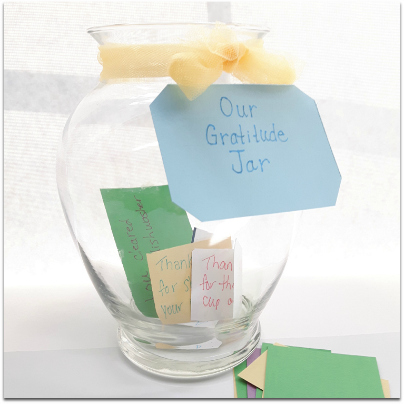 Benefits: makes gratitude a daily practice rather than just at Thanksgiving, birthdays or Christmas.
Benefits: makes gratitude a daily practice rather than just at Thanksgiving, birthdays or Christmas.
What you need: a large jar (dollar stores and large craft stores often have these, but a big pickle jar or any sort of container will also work; strips of paper; pencils, crayons or markers.
What to do:
- Decorate the jar: Write Gratitude Jar in the middle of a piece of paper and have kids decorate around the words, and then tape or glue the paper around the jar.
- Cut out strips of paper to keep near the jar.
- Have kids (and parents!) write down what they are grateful for, and put the strips in the jar: Kids could be grateful that a sibling shared a toy with them, or that it was a sunny day for the school picnic. Moms can write that they are grateful that their kid helped clear the dishwasher.
- Once every couple of weeks, or once a month, empty the jar and read the strips. Not only does this provide a trip down memory lane (remember the school picnic? or remember that time you lost your favorite stick and dad found it in the backyard?) but it also provides a subtle reminder that we have a lot to be grateful for. If your child is having a bad day, complaining that nothing ever goes right and grumbling about the unfairness of life, go through the jar and focus on the positive.
4) Money Envelopes
Make three envelopes for allowance money: one for saving, one for spending, one for charity.
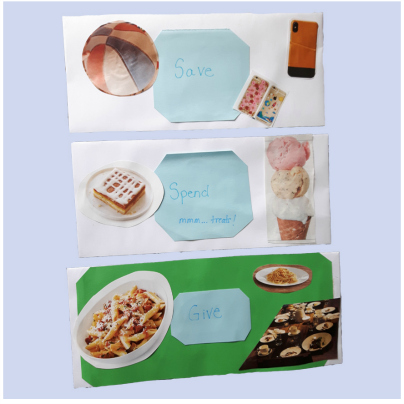 This is an excellent idea from Barbara Coloroso. It not only teaches kids to how to use money responsibly, but also makes them think about how they get things, prompts them to be grateful for what they have, and teaches them about charity and helping others.
This is an excellent idea from Barbara Coloroso. It not only teaches kids to how to use money responsibly, but also makes them think about how they get things, prompts them to be grateful for what they have, and teaches them about charity and helping others.
Benefits: helps kids to appreciate what they have and how they acquire the things they have.
What you need: three envelopes: these could be regular letter-size or larger manila envelopes. Crayons, pencils or markers; Magazines or flyers; Scissors, Glue.
What to do:
- This activity involves giving your child an allowance. This does not have to be an excessive amount; the amount is not the important part, it’s the concept behind the money.
- Write “Save” on one envelope, “Spend” on the second envelope and “Give” on the third one.
- Decorate the envelopes:
-
- Draw or paste pictures of the things the kids are saving for: a baseball glove, a bike, college…
- Draw or paste pictures of what they want to spend their money on: ice cream, a Lego minifig
- Draw or paste pictures representing the charity they are raising money for: Food if the charity is a food bank, or clothes if the charity is one that supplies clothes to homeless people, or books and pencils if the charity supplies these to kids in third world countries.
5) Gratitude Journal
A great craft activity for older children to write and illustrate the things they are grateful for each day, for example, a dinner out, friendship, a night at the movies…
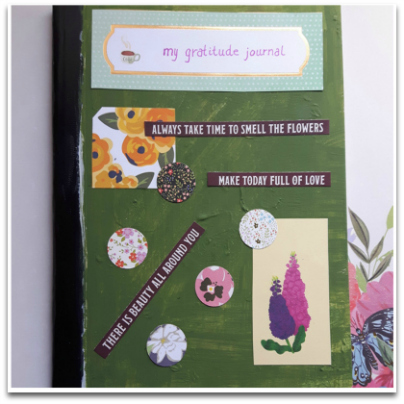 Benefits: helps kids focus on gratitude on a daily basis
Benefits: helps kids focus on gratitude on a daily basis
What you need: a blank notebook or a journal or agenda with dates and room to write each day; pencils, crayons or markers
What to do:
- Decorate the outside of the journal with artwork, doodles, or stickers
- Encourage a time each day or each week for your child to sit down and draw a picture or write about something they are grateful for that day or week.
- Having your kids sitting at the table or kitchen counter while you make dinner is a great time for this activity. It encourages conversation about what the kids are grateful for and can spark brainstorming and memories of all the great things that happened that day or week. If your child had a bad day, this is a perfect time to focus on the positive and find something that went well (even if it is only the prospect of a delicious dinner, if nothing else went well that day.)
Want more ideas about teaching gratitude and arts and crafts to work on? Check out the 7-Day Gratitude Challenge, or peruse Pinterest for tons of great art ideas.
There are lots of great articles on raising appreciative children. Combining an arts and crafts activity with a conversation about thankfulness and appreciation for others allows gratitude to become a way of life and not just something we practice at birthdays and Christmas.
2-Minute Action Plan for Fine Parents
- Put a weekly reminder in your calendar about allowance or contributing to the gratitude jar.
- Choose one or two (or all!) of the crafts described above, and make a list of any supplies you need to pick up.
- Discuss the crafts with your kids and get them excited about them.
Ongoing Action Plan for Fine Parents
- Carve out some time to make thank-you cards, add to the gratitude jar, or write in the gratitude journal.
- Encourage your kids to think about what they are grateful for on a daily basis.
- Take time to go through the gratitude jar or leaf through the gratitude journal from time to time.
- Talk about the charities your kids are saving for, and how they help others who are less fortunate.
- Have fun and remember that the money for “spending” is theirs to spend how they like. If they want yet another Lego minifig, then so be it.
- Make a point of expressing your gratitude to others, including your kids, whenever possible.
Love these ideas. We also have a pumpkin on the table this time of year and during dinner each write something we’re grateful for. It’s been a fun tradition with our now 6 y.o.
I love that tradition!
Thank you! All 5 are absolutely great! We haven’t tried all but Thank You Cards and Gratitude Jar are our staples for the last years. It is not only a great way to teach our children of how to be grateful for what they have but a really nice way of bonding together, sitting in the evening and discussing all the awesome things that happened to us as a family since the last time we’ve emptied the Gratitude Jar. And Thank You cards are also a great present to teach your youngest kids to make for their grandparents. It makes a really nice gift!
Thanks for the comment – I love that you have that family bonding time!
It feels good to teach children about good moral characters. I got a 5-year-old and guess what? She won’t let me go if I won’t say thank you to her. I’m just making funds when I do that to her by the way.
It’s always better to start teaching them when they’re still young. Great article!
Thanks!
A great craft activity for older children to write and illustrate the things they are grateful for each day, for example, a dinner out, friendship, a night at the movies…
Thank you for the beautiful reminder! We’ve started money envelopes and gratitude jars and they work wonders, I’ll try your other tips too. Actually I notice my daughter (6) has always naturally written thank you cards and she stops in front of every flower :o). My son (9) has never really naturally done this, but spending time with him in front of a sunrise, or a small animal, having flowers and plants in his room, he has become such a thankful kid! And, in turn, I think because he is so appreciative, he is also so caring when he sees others do things for the family and he loves to make himself helpful too! thank you and all the best!
Wonderful comment Emanuela – lovely to hear from you!
Perfect – thanks Leslie!
There are so many reasons to help children develop a gratitude habit, not least of which is that it helps them reduce stress. Finding things to be grateful for in their immediate surroundings is a way to conquer back-to-school nervousness. Gratitude also helps them maintain their sense of wonder.
Thanks Anne – I completely agree!